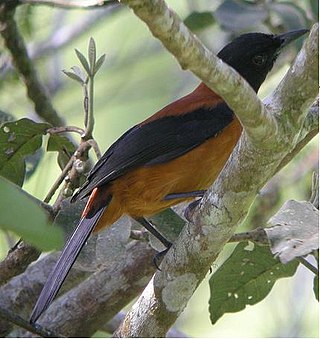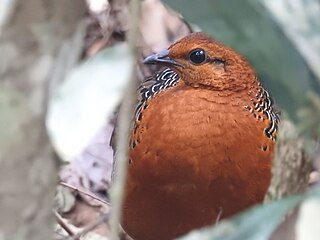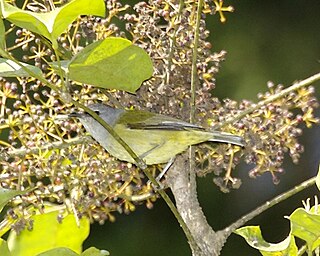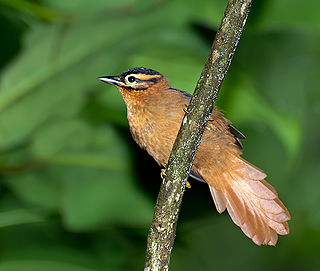
The rockjumpers are medium-sized insectivorous or omnivorous birds in the genus Chaetops, which constitutes the entire family Chaetopidae. The two species, the Cape rockjumper, Chaetops frenatus, and the Drakensberg rockjumper, Chaetops aurantius, are endemic residents of southern Africa. The Cape rockjumper is a resident of the West Cape and south-west East Cape, and the orange-breasted rockjumper is distributed in the Lesotho Highlands and areas surrounding them in South Africa. The two rockjumpers have been treated as separate species but differ in size and plumage. The ranges do not overlap, but come close to doing so. Also found in the mountain of a small town Middelburg in the eastern Cape where they are protected because they are endangered species.

The Pachycephalidae are a family of bird species that includes the whistlers, shrikethrushes, and three of the pitohuis, and is part of the ancient Australo-Papuan radiation of songbirds. The family includes 69 species that are separated into five genera. Its members range from small to medium in size, and occupy most of Australasia. Australia and New Guinea are the centre of their diversity and, in the case of the whistlers, the South Pacific islands as far as Tonga and Samoa and parts of Asia as far as India. The exact delimitation of boundaries of the family are uncertain, and one species, the golden whistler, has been the subject of intense taxonomic scrutiny in recent years, with multiple subspecies and species-level revisions.

The hooded pitohui is a species of bird in the genus Pitohui found in New Guinea. It was long thought to be a whistler (Pachycephalidae) but is now known to be in the Old World oriole family (Oriolidae). Within the oriole family, this species is most closely related to the variable pitohuis in the genus Pitohui, and then the figbirds.

The wattled ploughbill is a small bird from New Guinea. It is the only member of the monotypic genus Eulacestoma and family Eulacestomatidae. It is also known as the wattled shrike-tit or ploughshare tit.

The caribs are a genus, Eulampis, of hummingbirds in the family Trochilidae. The genus contains two species, both of which are endemic to the islands of the Caribbean. The genus name comes from the Ancient Greek word eulampēs meaning 'bright shining'.

The ferruginous partridge is a species of bird in the family Phasianidae. It belongs to the monotypical genus Caloperdix. It is found in Indonesia, Malaysia, Myanmar, and Thailand.

The barred rail is a species of rail found across the Philippines, Sulawesi (Indonesia) and Salawati. The species is common, but shy and difficult to see.

The chestnut-naped forktail is a species of bird in the flycatcher and chat family Muscicapidae. The species is monotypic, having no subspecies. It is found in Sundaland, in southern Burma and Thailand to Peninsular Malaysia, as well as Sumatra and Borneo. The species is not migratory.

The crested hornero is a species of bird in the Furnariinae subfamily of the ovenbird family Furnariidae. It is found in Argentina, Bolivia, and Paraguay.

Heleia is a genus of birds in the white-eye family Zosteropidae. One species, the spot-breasted heleia is restricted to the island of Timor. The pygmy white-eye is endemic to the island of Borneo. The thick-billed heleia, occurs on Flores and Sumbawa.

The African shrike-flycatcher or red-eyed shrike-flycatcher is a species of bird in the family Vangidae. It is the only species in the monotypic genus Megabyas.

The melampittas are a family, Melampittidae, of New Guinean birds containing two enigmatic species. The two species are found in two genera, the greater melampitta in the genus Megalampitta and the lesser melampitta in the genus Melampitta. They are little studied and before being established as a family in 2014 their taxonomic relationships with other birds were uncertain, being considered at one time related variously to the pittas, Old World babblers and birds-of-paradise.

The crested bellbird is a medium-sized passerine bird in the family Oreoicidae. It is native to drier parts of Australia where its typical habitats are acacia scrublands, eucalypt woodlands, spinifex and saltbush plains, and dunes. The male is about 20 cm (8 in) long and has a grey head, a black crest and breast, and a grey or olive brown body. The female and juvenile are similar but the colours are more muted and the black breast is lacking. The distinctive call is a high pitched bell-like sound, audible at some distance. Sometimes a pair of birds duet.

The fernwren is a species of bird in the family Acanthizidae. It is monotypic within the genus Oreoscopus.

The rusty whistler is a species of bird in the family Pachycephalidae. It is endemic to lowland mountain areas of New Guinea. Its natural habitat is subtropical or tropical moist lowland forests.

The crimson-fronted cardinal is a bird species in the tanager family (Thraupidae). It is not very closely related to the cardinals proper (Cardinalidae). It is endemic to Brazil.

Philydor is a genus of foliage-gleaners, birds in the ovenbird family Furnariidae. It contains the following species:

The piping bellbird, or crested pitohui, is a species of bird in the family Oreoicidae. It was previously placed in the family Pachycephalidae.

Esacus is a genus of bird in the stone-curlew family Burhinidae. The genus is distributed from Pakistan and India to Australia. It contains two species, the great stone-curlew and the beach stone-curlew.

Pitohui is a genus of birds endemic to New Guinea. The birds formerly lumped together as pitohuis were found by a 2008 study that examined their evolutionary history on the basis of the genetic sequences to have included birds that were quite unrelated to each other. They have since been separated into other genera.



















